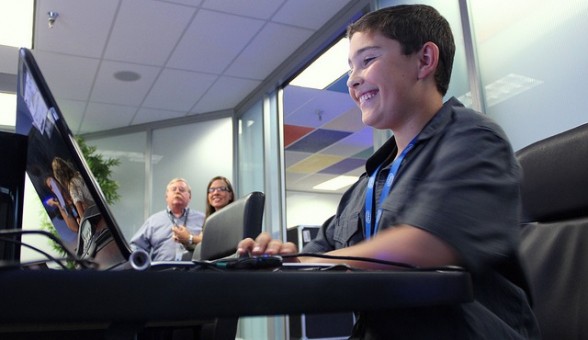Helping Your Child Succeed With Technology

This post originally appeared on A Platform For Good.
Many educators speak about preparing students for their future; for now, I would be content with the present.
As a teacher, it is my responsibility to prepare my students for their future. It is not enough to claim that I will equip my students with 21st Century skills as I am already 14 years late for that. Instead, I do my best to help them develop skills such as flexibility, adaptability, and creativity, and to learn that mistakes aren’t bad but rather an opportunity to grow and learn.
Along with these competencies, I need to help my students develop proficiency with today’s modes of communication, including how to effectively use technology. While there are still some who bother to have the debate about whether technology helps students to learn better, I believe this is now a futile debate. Our students need these skills as technology is simply today’s pen.
As a fellow parent and father of three, I believe there are many ways that parents can help to set their child(ren) up for success with technology, and to put them on the right path toward the effective and appropriate use of it as well.
Expose Them to Multiple Platforms
While some students are quite proficient using an iPad, they may struggle when using a PC. Furthermore, as many school boards are mainly deploying Windows based PCs, nearly all of their students find it challenging to work with a Mac Operating System. As technology will no doubt continue to evolve, it is best if students are exposed to multiple platforms, including: Windows, Mac, IOS, Android, and Linux. Being comfortable using any and all operating systems that they encounter will only benefit them as they will be more able to adapt to a diverse range of technologies in the future.
Limit and Maximize Screen Time
A wealth of research has been conducted and much has been written on the effects of screen time on kids. If you haven’t already, educate yourself and your children on the topic. A good place to start is with Ways to Manage (and Improve) Your Child’s Screen Time by Dr. Elizabeth Milovidov.
In addition to limiting passive screen time, you should focus on maximizing active screen time. There are many fantastic educational apps and websites to choose from that allow your children to create something novel rather than just watching something that someone else created.
One of the best things our children can spend their time on is learning to code. Websites such as code.org, codeacademy.com are great places for children as young as 5 to start understanding the basics of coding. While these websites are geared toward beginners, more experienced students would benefit from working through the modules as a primer. More advanced skills can be developed by working through the activities of the Khan Academy Computer Programming site and Google’s Blockly site.
Model Responsible Use of Tech
A great deal of research has been done on the importance of creating a literacy-rich home environment, whichhis goes far beyond having readily available books for your children to read. Research supports that families can encourage language and literacy development by creating a home environment where there is lots of reading, writing, talking, and listening. Children look to their parents as models for all behaviors and when children see their families reading often, and engaging in conversation with them, it serves as a natural motivation to engage in those same behaviors.
This same thing can and should happen with regards to the use of technology in the home; children will also pick up on habits and practices of their parents in this domain. For instance, if children see their parents using their cell phone at the dinner table, they will naturally think this is acceptable and will do so themselves. Conversely, if children see their parents use technology in appropriate and responsible ways, they will likely develop those habits as well. Decide what is appropriate and responsible in your home and model those practices.
Digital Footprint
As a student in elementary and high school, I made all kinds of mistakes. Some of those errors in judgment were quite public. But thankfully, those mistakes were not immortalized on YouTube or Twitter; they have decayed like memories in the minds of the people who were present.
Today, our children need to understand that the stakes are higher when they do or say things using social media and on websites. Even applications such as CyberDust andSnapChat that tout the ability to erase your words, pictures, and videos instantly are not immune to the other user taking a screenshot.
Having an open and ongoing dialogue about digital footprints is a great way to help your child make informed decisions as they navigate the constantly evolving digital landscape.
While some classrooms, schools and districts require their students to check their technology at the door, I would much rather take the approach that educators should try and teach students to use these devices appropriately and effectively, to learn to be responsible and reap the benefits of what technology has to offer today’s citizens. In our constantly evolving digital landscape, the responsibility for this goal should not rest on the shoulders of the education system alone, but be a collaborative effort with the home.
Cover image courtesy of Flickr.

No comments:
Post a Comment